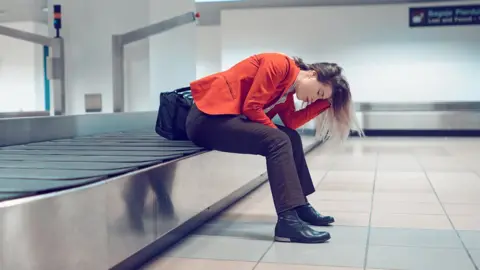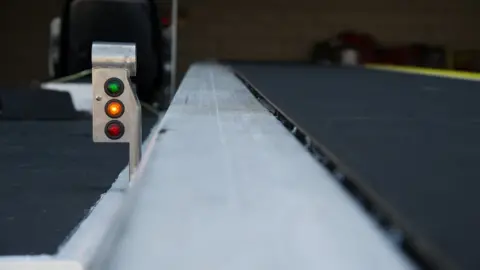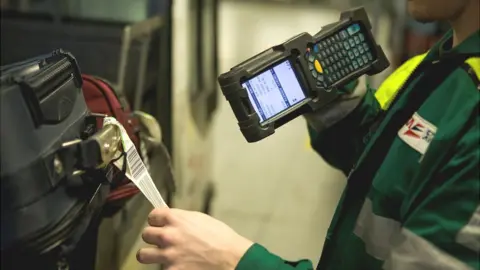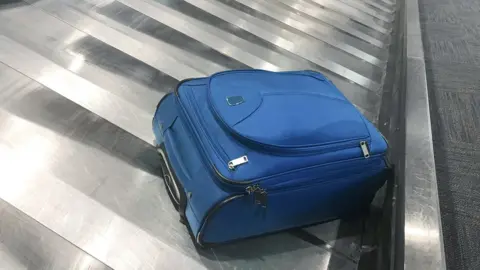Why do airlines still mislay 25 million bags a year?
 Getty Images
Getty ImagesThe airline industry claims it's getting better at not losing our luggage, partly through improved tracking technology. But tens of millions of bags still go astray every year. So is it doing enough?
It's the most disconsolate feeling - waiting for your bag to appear on the luggage carousel after all the other passengers have picked up theirs.
And it doesn't show up.
A frustrating experience for millions of air passengers. But why does it happen?
How can an industry that employs the very latest technologies in its aeroplanes and air traffic control systems still be so backward when it comes to our luggage?
But first, let's start with some good news.
Sita, an international IT provider to the industry that monitors global baggage handling, says that the total number of "mishandled" bags has fallen from 46.9 million in 2007 to 24.8 million in 2018.
And this is during a period when the total number of air passengers nearly doubled.
 Alec Thomas
Alec ThomasInvestments in tracking technologies, Sita says, are paying off.
For example, US airline Delta now includes a tiny RFID [radio frequency identification] tag in the familiar barcoded label that goes around your bag handle. This means each bag can be scanned automatically by machines as it weaves its way through the airport system.
Wandering bags can be spotted more easily via a central monitoring system.
"You could assume that of the 150 million bags we're moving every year, each one is getting a tag," says Gareth Joyce, an executive at Delta.
Delta now claims to handle 99.9% of its customers' bags "perfectly". Other airlines are also incorporating RFID tags, and mobile scanners for baggage handlers.
But 25 million bags - out of 4.3 billion bags in total - still get misdirected or lost every year. Why?
 Reuters
ReutersNearly half of all bags that go astray do so because of problems with flight transfers, Sita says. Delayed flights have knock-on effects - your bag just doesn't make it to the connecting flight in time. And a significant proportion of missing bags are down to passengers or handlers simply picking up the wrong one.
Another contributory factor could be the complexity of the handling system. At some airports, airlines employ their own handlers, but at others the handlers are independent and contracted to multiple airlines.
The International Air Transport Association (Iata) standard for encoding information about luggage dates from 1989. And the barcode label system has been around since the 1950s. In some smaller airports, even these labels are still not routinely scanned.
Technology provider Zebra, for example, recently announced that it had supplied 230 mobile computers to baggage handlers at 14 Greek airports just to enable them to scan bag label barcodes.
 SITA
SITA"There would have been a lot of pen and paper in place," says Zebra's Dean Porter.
With many travellers going island-hopping, that sometimes led to lots of bags going astray. It's an experience passengers visiting small airports in Europe may also be familiar with.
An overhaul is long overdue.
Last year, Iata brought in a new regulation - Resolution 753 - aimed at making airlines and airports take better care of our luggage. Bags must now be checked as present and correct at several key points along the journey, explains Iata's Andrew Price, including when they are loaded on to the plane and when they enter the transfer system at airports.
And last month it voted to support the implementation of RFID tags throughout the industry, a move that could save it $3bn (£2.4bn), the body says, even after taking in to account the costs of new equipment and monitoring systems.
Trying to locate mislaid bags then ferrying them round to disgruntled customers costs a lot of time and money.
 Getty Images
Getty Images"Considering that baggage is perceived as quite a dull area …there's actually a massive amount of quite interesting technology and investment going on," explains Mr Price.
Delta, for instance, is experimenting with machine learning to spot lost luggage patterns and identify weak points in the system, such as particular destinations or bag types that are more problematic than others.
Other innovations include airline apps that update customers on where their bags are at any given moment. While this doesn't necessarily affect how well the bag is handled, passengers seem to appreciate having more information at their fingertips.
For example, Siberian carrier S7 Airlines offers a baggage-tracking app for its 16 million annual passengers, and just over half now track their bags this way. Plenty of other airlines, such as United and American Airlines, also offer a similar service.


Europe has by far the worst baggage handling performance, according to Sita. The continent clocks up 7.29 mishandled bags per 1,000 passengers annually, compared to 2.85 in North America and just 1.77 in Asia.
Of course, you can take matters in to your own hands and track your own luggage using a GPS or mobile network tag. The device sits inside your bag and broadcasts its location from anywhere in the world to the companion smartphone app. Makers include LugLoc, Trakdot, Tile and Smart Unit.
 Getty Images
Getty ImagesSo what happens to luggage that is either lost or stolen rather than misdirected? Only 5% of mishandled bags fall in to this category, says Sita. Any that end up in airport lost luggage departments are generally kept for a few months before being destroyed or sent on to auctioneers.
"We've had all sorts, from dentures to artificial limbs," says Sam Ewing, associate director of BCVA, a Bristol-based auction house.
"Everything you could possibly imagine you would take to go from A to B."
In the US, the Unclaimed Baggage Center in Alabama offers unclaimed luggage for sale that it has bought from airlines. Its website boasts: "You never know what you'll find!"
If the airline industry finally gets it act together, such services may - eventually - no longer be needed.
